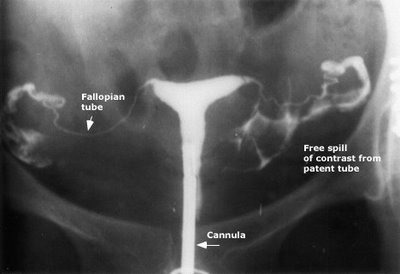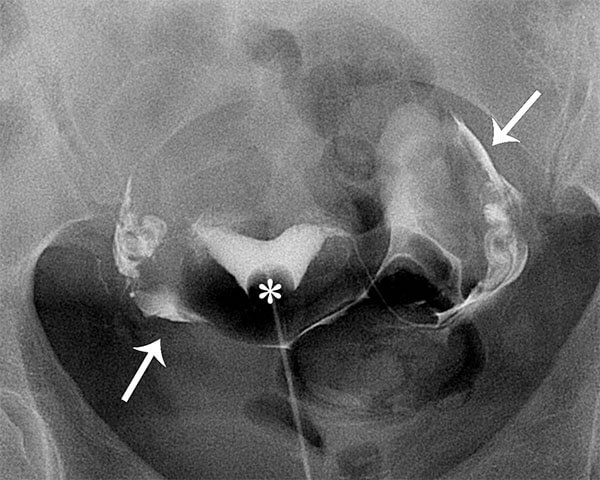Hysterosalpingogram or HSG test- also referred to as uterosalpingography, evaluates the condition of the lower abdominal organs, including the uterus and fallopian tubes. The procedure uses fluorescent X-rays to determine whether the fallopian tubes are blocked or rule out abnormal uterine deformities.
Infertility in women can be due to distorted uterus structures or blocked fallopian tubes. These uterine anomalies, accounting for approximately 7.3% of total infertility, can be congenital, implementing recurrent miscarriages in women. HSG test, a diagnostic procedure, allows the doctor to look into the structural anomalies of the uterus and fallopian tubes.
This article explores everything you need to know about HSG, its procedure, benefits, and risk factors.
In this Article
HSG Test: What is it?
HSG Test is a medical diagnostic test performed to examine the condition of your uterus and fallopian tubes. HSG test involves injections of a contrast medium into the uterus and an X-ray taken to determine whether the reproductive cavity is devoid of anomalies.
The HSG evaluation utilises a radio-opaque material called contrast dye, fluoroscopy, and image intensification. However, while studying the tubal structure, spilling of the contrast liquid across the tubes is observed.
HSG is preferably done during the follicular phase of the menstrual cycle, i.e., day one to day fourteen of a 28-30 day menstrual cycle- the time when the chances of pregnancy are low.
With no prior prerequisites for the test, HSG investigations take a minimum of 5 minutes. However, you will need to be there 30 minutes earlier before the test. Also, it is essential to discuss the medications you are taking with your doctor before the test. For post-test discomfort, your doctor may suggest over-the-counter pain relievers and antibiotics.
Why is an HSG test done?
HSG test looks into the possibilities of blockages or anomalies of the reproductive anatomy. HSG is a histological test performed by the radiology facility to check the internal status of the female reproductive system. The reasons for conducting an HSG test are:
- To check the cavity is devoid of fibroids, polyps, or scar tissue,
- To detect the causes of infertility or map out the reason for problems related to pregnancy,
- To confirm if the fallopian tubes are open and if the uterus is normally structured or not,
- HSG test, after tubal sterilisation or tubectomy, checks the status of blocked fallopian ducts,
- It helps highlight reproductive tract disorders, congenital uterine malformations, Asherman’s syndrome, tubal occlusion, and pelvic inflammatory diseases (PID),
- Helps understand the reproductive potential of a woman.
How is an HSG test done?
Though the HSG test takes not less than five minutes, it involves the placement of a thin, plastic catheter inside the cervix and the insertion of a dye into the cervix with the help of a catheter. The fluorescent dye occupies the uterus and travels through the tubes, spilling the contrast dye out of the cavity. The radiologist takes an X-ray as the contrast dye fills the uterus and moves through the cavity. Here is a detailed step-by-step procedure of the HSG test.
- The speculum, a metal instrument, is inserted into the cervix through the vagina to dilate the reproductive tract, allowing easy viewing of the internal organs.
- The cervix is cleansed of germs and mucus.
- The upper cervical region may be numbed temporarily with local anaesthesia.
- There are two methods of dye insertion. One is with the help of a thin tube called a cannula. And the second method is using a narrow glass tube having high capillarity and a balloon covering at one of the ends.
Image Source: HSG test done using a thin tube called cannula.
Image source: Normal HSG showing catheter with balloon (*) inside of the uterus. Contrast material fills the uterus and flows through both fallopian tubes spilling into the pelvis (arrows), confirming no blockage.
- After the administration of the contrast dye, the speculum is removed, and an X-ray is taken. The fluid slowly fills the lower abdominal cavity-the uterus and fallopian tubes. The contrast fluid makes its way into the fallopian tubes, stretching the fallopian muscles even when it gets blocked.
- HSG, a special X-ray performed by radiology experts, allows imaging due to the slow flow of the contrast dye or fluid.
- If there are no fallopian tube blockages, the fluid will overflow through the extreme distal end, and the body absorbs it.
- After the X-ray, the cannula or the glass tube is removed gently.
HSG is an outpatient procedure that can be done in a hospital or a clinic set up by radiologists.
During the test, you may have slight discomfort due to dilation and insertion of a contrast medium. Anaesthesia administration can reduce discomfort symptoms. Post HSG procedure, doctors may prescribe necessary painkillers and antibiotics to help alleviate pain and abrasion in the vagina.
Benefits of HSG test
Though HSG is a diagnostic procedure, it is known to give therapeutic benefits.
- In some instances, the oil-based contrast medium administered into the reproductive tract can improve the chances of pregnancy by ten times compared to the water-based contrast medium.
- The flushing of the fallopian tubes and uterine cavity in HSG can increase pregnancy probabilities 3.6 times compared to no HSG test. The test with an oil-based medium cleanses the minor constrictions and tubal defects.
- X-ray imaging helps identify the cysts, polyps, and fibroids and understand the exact cause of fertility. Sometimes, HSG tests also help identify malignant cysts.
Risk Factors and Side Effects of HSG test
Post HSG test, you may have sticky vaginal discharge with the contrast medium draining from the uterus. Sometimes, these discharges are accompanied by blood. In such scenarios, avoid tampons and instead opt for sanitary napkins that can help soak the blood discharge. Some of the common side effects after an HSG test are:
- Slight abdominal pain or discomfort
- Vaginal discharge or spotting
Though very rare, if the abdominal pain gets severe and is accompanied by vomiting, dizziness, fever, chills, foul-smelling vaginal discharge, or heavy blood flow, you will need to consult your gynecologist immediately.
HSG is not advised during pregnancy or if a woman has a pelvic infection or heavy bleeding during the procedure. HSG during such cases may lead to severe infections or allergic reactions.
HSG test price in India
The HSG test cost ranges anywhere between Rs.760 to Rs.3600 in India. It depends on the laboratory, expertise of the radiologists and many other cost-influencing factors. The cost of HSG in the prime cities of India are listed below.
| Major Indian Cities | Approximate basic HSG cost |
| Hyderabad | ₹ 760.0 |
| Kolkata | ₹ 1216.0 |
| Ahmedabad | ₹ 1300.0 |
| Jaipur | ₹ 1400.0 |
| Lucknow | ₹ 1700.0 |
| Delhi, Faridabad, Gurgaon, Noida, | ₹ 1980- ₹ 2000 |
| Mumbai | ₹ 2400.0 |
| Bangalore or Bengaluru | ₹ 2600.0 |
| Chennai | ₹ 2600.0 |
| Visakhapatnam-vizag | ₹ 3150.0 |
NOTE: The above mentioned costs are subject to change
Also Read: https://pregajunction.com/blog/intrauterine-insemination-iui-process-success-rate-cost/
Conclusion
HSG test is a diagnostic test that can help identify major structural defects of the uterine cavity and fallopian tubes. Though the HSG procedure may be complicated as it involves the insertion of the contrast fluid that can help in imaging, it is performed by highly skilled radiologists who complete the HSg procedural tasks within 5 minutes. Contact your doctor to understand more about the HSG procedure or know when you can take the HSG test.






